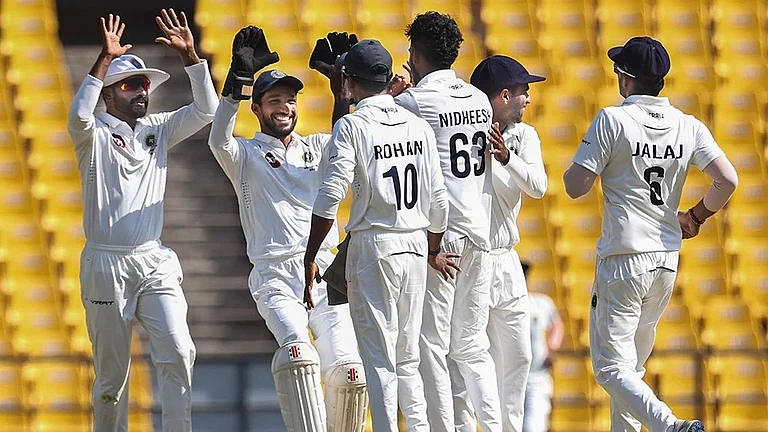What started with good old Doordarshan’s pioneering daybreak discourses was fleetly espoused by almost all satellite channels, culminating in Maharishi Veda Vision, Sanskar, Aastha and, most recently, Sadhna, all with an overtly Hindu bent, much like the Christian agenda of God TV, the Syro-Malabar Church-promoted Jeevan TV, MiracleNet, Eternal World Television’s Global Catholic Network and Human Upliftment Organisation’s Golden Age Television. And as Muslims appropriated specks of Pakistan TV and Arabic channels, the Sikhs have leaned towards Alpha Punjabi, Lashkara and ETC Punjabi for their feed of telly spirituality—the latter prized by expats for Gurbani beamed from Amritsar’s Golden temple. And this plethora hasn’t kept more players from sallying into the fray. ATN International’s bilingual Ahimsaa TV debuted on Gandhi Jayanti this year, and Sanskriti and Sudarshan TV are in the works.
Eyeball dynamics bear out the enthusiasm. At least 50 per cent of the 40-plus age group, accounting for over 60 per cent of the estimated 150 million viewers in the 24 million cable homes in India, are believed to have taken to spirituality on the tube. A share that’s poised to surge with higher cable and satellite TV penetration in India, which, reports Media Partners, stood at 53 per cent in 2002 and will scale up to 65 per cent by 2015 astride a subscriber base of 96 million. The overall current share of religious channels may be a scrimpy 1 per cent, but it still translates into an average weekly reach of 15 million (TAM Media Research) for the five major channels in July ’03 (see chart).
Spiritual channels, like the rest of their free-to-air clan, survive on airtime sales and sponsorships (God TV also receives donations). Their modest tariff cards have steadily drawn advertisers looking to improve niche exposure and campaign frequency. "The advertiser finds that our viewer is patient and doesn’t surf channels," asserts Dilip Kabra of Sanskar.
On their part, the Hindu channels are just waking up to the idea of content being the key differentiator. But as Ashish Bhasin, director, Integrated Marketing Action Group, Lowe India, avers: "As of now, all channels look the same. The content begs improvement." Kabra is more realistic: "A lot needs to be done, but issues of financial viability stifle costly projects...."
Which is where usps atrophy. Like in real-world spirituality, those who believe in nothing can be seen lapping up virtually anything. One sees celebrity speakers like Sudhanshuji Maharaj trailed by a growing breed of self-appointed masters claiming to interpret ancient esoteric knowledge, chivvying nebulous notions of inner peace. Souls materialistic are lambasted for their ever-growing possessions by ever-more expensive gurus. One wonders if the speakers and audiences are animated as much by the ideas at hand as by the presence of a TV camera; or if cant is a natty shortcut to social acclaim.
It’s the swelling throngs at gala discourses that inspired channels like Sanskar in the first place. Says Kabra: "The country is imbued with spirituality...there existed a ready audience." Rakesh Gupta, MD, Sadhna TV, was spurred by the tightening tentacles of the soap culture: "Sadhna was envisaged as a medium to extricate viewers from the imaginary world of fiction, where vices are shown in the name of Indian culture and producers play with the emotions of viewers."
Passion is all right. But it can’t offset tentative production standards, poor execution. How can content like home videos of devotional songs and congregations ever poach upon the audiences of chic soaps and film shows? Kabra insists it’s a myth that home videos do not amount to quality content. "Not only would you find high levels of devotion in them, they also showcase promising singers," he explains.
The channels are also changing tack, to claim the attentions of diverse age groups. Some like the Kochi-based Jeevan TV have become entertainment channels with spirituality confined to daily slots. Others are zooming in on younger age groups with programmes on yoga, Art of Living.
A flip through Aastha and Sadhna unleashes a slew of astrologers and Vaastushastra or Feng Shui experts bombarding you with contact details and rate cards for various ‘services’. Aren’t these channels becoming ready vehicles of promotion for some? Gupta concedes they are, but adds: "These subjects are closely related to our culture, scientifically proven and popular. Even the government is approving full-fledged courses in astrology and vaastu."
The political abuse of the medium is another apprehension. Political analyst A.S. Ojha recently told a news agency: "These channels may not be party to poll pandering but our right-wing parties will discover ways to use them to legitimise their ideologies." TV producer Kiran Mittal trod a step ahead. "They have a political slant," he declared. "When they talk of promoting Indian heritage, why do they only promote Hinduism and no other religion?" Gupta spars: "We are only spreading the message of peace and harmony enshrined in Hinduism...to talk about India without Hinduism is like talking about a person without a conscience." Iqbal Malhotra, director of Delhi-based aim Television, concurs: "The channels are not purveying a militant Hindu line. There is no evidence of a party or ideological line. They are tapping into a niche, a lucrative market thirsting for a blend of eastern spiritualism, western precepts."
Which way do you then look at the likes of God TV? Reveals Thomas Robinson, channel director for Asia and Middle East: "Our channel is about spreading the love of God, helping people find God. It’s not about a religion but about the person Jesus who brings joy and peace into our lives." Are such Christian channels stabs at countering the Hindu movement? Robinson denies it: "We respect the varied culture and beliefs of everyone and have nothing to do with the Hindu movement."
So is all this marking a waypost in the evolution of a certain genre, undecided about distinctions between institutional religion and bona fide spirituality. Says Santosh Kumar Jain, MD, ATN International: "Ahimsaa believes in a multi-religious platform, a new market in the area of social TV aimed at all age groups and faiths. (But) I don’t think there’s anything wrong with channels focusing on one faith, like MTV focuses on the youth." Says Suresh Chavanke, COO, Sudarshan TV: "We want to blend socialism and spiritualism and replace the political bent of social activities with a philosophical bent."
All in all, the concepts seem worthy, pronounces Bhasin, but "they’ll succeed only through a mix of entertainment and education. And in the long run, only one or two players will survive in every genre."
So talk of commercialisation of spirituality be damned, is it time to give in to the spiel? As Sri Sri Ravi Shankar says, "The mind has become commercial and can only be captured commercially." Amen.


























